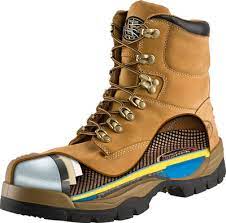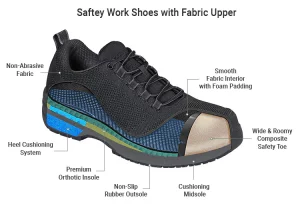Table of Contents
Have you ever wondered what’s the difference between steel toe and carbon toe, and composite toe, and nano toe, and some alloys, like aluminum alloy toed boots? Today we’re going to compare steel toe boot and composite material toe boot. Let’s get into it a little bit!
What Are Inside Steel Toe Boot and Composite Toe Boot?
First off, let’s see what the inside of these boots are.
We’ll start out with is the steel toe. If you’ve cut the boot, you’ll see that there is a steel plate that sits on top of the toe area. Threre is a really solid stuff inside – this is to protect your toes from any potential crushing injuries. The steel toe can also come in handy if you happen to drop something on your foot while wearing these boots.
The next boot I want to talk about is the composite toe. These boots have a little different inside then the steel toe. With the composite toe, you’ll find that there is a Kevlar or carbon fiber plate that sits on top of the toe area. This is to protect your toes from any potential crushing injuries as well. The composite toe can also come in handy if you happen to drop something on your foot while wearing these boots.
Carbon toed boots are really just another kind of composite material. It’s just a little bit different kind of composite. So they actually use carbon fiber. When you look at the material inside, it actually looks like a carbon fiber hood would look like on a vehicle. So it has the same properties as just regular fiberglass. It’s some kind of fiber matting and then layers of different glues and other materials that they put together this hard composite.
Generally, composite and carbon fiber are a little bit thicker material to achieve the same rating that a steel toe boot would have. They have a little bit more material, but both of them are about the same thickness.
Steel Toe: Main Features
Weight
Steel toe boots are definitely among the heaviest of boots. There’s metal in the boot. And if boots weren’t heavy enough as they were, adding steel to them is going to only make them heavier. So if you’ve ever worn steel toe boots or any real work boots, you already know that there’s weight to them already. But steel toe boots adds a whole other layer of weight to them. So by the end of the day, you feel more tired, your feet start to ache wearing heavy boots on all day long.

Durability
One benefit of steel is that steel doesn’t crack. So if something were to drop on them, roll over them or something like that, the material itself is not going to crack. It’s going to fold and bend, but it’s not going to crack and shatter into smaller pieces. This is because the steel plate is not going to break down over time like the composite material can. If you are looking for a boot that is going to last you a long time, then the steel toe is the way to go.
Thermal Conductivity
One bad thing about steel is that it is thermally conductive like a MF. So if you’re in a cold environment, that is going to conduct through your boots, and your feet are going to be cold because the metal conducts cold really well. Same thing with heat. If you’re in a really hot environment, that heat will transfer into your foot through the metal.
Price
Steel toe bootsre going to have the cheapest price tag. That’s not always necessarily true. A lot of the brands kind of dictate what the pricing is. here’s a lot of other reasons why price kind of drives a little bit differently for one brand over another brand. But by and large, for the most part, steel is going to be the cheapest of the options.
Composite Toe: Main Features
Weight
The big answer to the weight issue that steel has is a composite toe. So composite just means that they’ve taken a whole bunch of different materials, they’ve put them together kind of into this hard plastic really. But it’s a lot lighter weight than steel.

Durability
The downside is that composite toe can crack. They can actually develop cracks. A composite would crack if it’s impacted, these could crack as well. They could form little hairline cracks or actually just crack from impact if the impact is over a certain threshold.
Thermal Conductivity
The other added benefit to this is the thermal resistivity. So it’s not as thermally conductive. But if you have cold temperature outside trying to get into your feet, it’s not going to conduct as well. And that’s a really good thing considering most of us are wearing these boots all day, every single day regardless of the weather or the conditions.
Price
These are generally a little bit more expensive than steel toe. Again, the brand is going to dictate that as well as the type of boots, the environment that they’re built for, if they’re slip resistant, puncture resistant, electrically rated, any of that stuff. But generally they’re a little bit more expensive, still kind of a middle of the road price for a boot.
Carbon Toe: Main Features
Weight
The benefit of getting the carbon toe over the composite is carbon fiber is even more lightweight as a material, as a composite material. So you have more lightweight, easier to wear around every day pretty much.
Durability
The downside with carbon fiber is just like fiberglass or most the composite materials, there is the possibility of ripping or tearing that fabric, cracking the fabric, or developing some kind of hairline crack that can split a little bit. That is just a possibility, whereas the steel is not going to have that.
Thermal Conductivity
You have thermal conductivity that’s even greater than that of the composite toes. You could wear normal boots out in the winter and not have to worry like a steel toe boot would let that snow and that really cold weather, that water, all of that temperature come through the boot. Whereas a carbon fiber’s going to do the best job of not allowing that to happen.
Price
For a price tag, carbon toed boots are going to be your more expensive. Probably not quite as expensive as the carbon nano tube boots, the nano boots that are coming out these days. But out of the three, out of the steel, the composite and the carbon, they’re going to be the more expensive.
Steel Toe VS Composite and CarbonToe: Comparative Table
We summurise all the facts about Steel Toe and Composite and Carbon Toe into this comparative table, hope it will give some clues to help you make a right choice.
| Durability | Toe’s Thickness | Thermal Conductivity | Weight | Price | |
| Steell Toe | High | High | High | High | Low |
| Composite Toe | Low | Medium | Low | Medium | Medium |
| Carbon Toe | Low | Low | Low | Low | High |
Video: Steel, Aluminium and Composite Toe Caps Explained
Other Features To Consider
There’s a lot of other ratings and things that happen with boots that can change that, whether you have metatarsal protection or something. So really, when you go looking for boots and you’re looking at carbon toe, steel toe and composite toe, you need to know that there are other material properties to consider besides the ones listed above.
There are many other features such as whether it is a static dissipator, whether it has a shock hazard rating, whether it is slip resistant, puncture resistant and more. So really, you need to do your research and figure out which boot is best for you and your needs.
How To Make Safety Boots More Comfortable?
Once you have the right size and style of your safety boot, there are a few things you can do to make sure your steel toe or composite toe boots are as comfortable as possible.
First, make sure you break them in before wearing them for an entire work day. Wear them around the house for a few hours each day until they feel comfortable.
Second, if you’re going to be wearing your boots for long periods of time, invest in a good pair of socks. Wool socks are a great option because they will help keep your feet warm in the winter and cool in the summer.
Third, if your boots are starting to rub or cause blisters, try using moleskin or bandages to help prevent further irritation.
Fourth, if your boots are still giving you trouble after trying all of the above, consider taking them to a shoe repair shop to see if they can make any adjustments or repairs.
Remember, steel toe and composite toe boots are required in many workplaces for a reason – they help keep you safe. But that doesn’t mean they can’t be comfortable too. With a little bit of care and attention, you can make sure your boots fit well and feel great all day long.
Bottom Line
The bottom line is that both steel toe and composite toe boots have their own set of pros and cons. It really depends on your needs as to which one you should choose. If you need a light weight boot, then the composite toe is the way to go. If you need a durable boot, then the steel toe is the way to go. But really, it all comes down to your needs. Bedides, you need check the price befor making your decision!